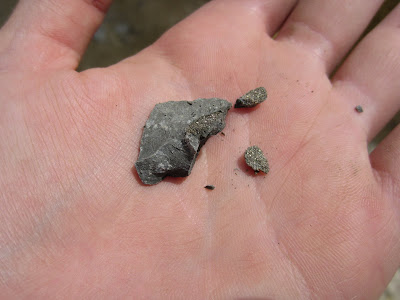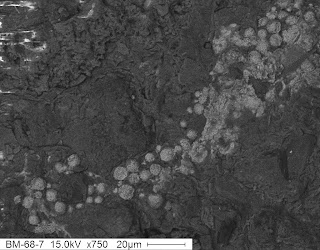So this week (five) I have been compiling my pyrite framboid diameter data after measuring them with the "imagej" program. The samples I did take BSE images of, totaling seven, were put into histograms with % of frequency on the y axis and framboid diameter in the x. I also made box and whisker plots for the same samples to compare the two graphs and see which one I happen to like better, histogram wins--at least with me (ahem...Diana). Ill post an example(s) histogram on the blog.
After I make the graphs I had to make some observations. So what I first did is I used the excel program to find max framboid diameter, mean diameter, and standard dev. I also had to find the inchofabric indexes of some of the samples that had none. So now that I had that info and the histograms I found that with increasing inchofabric index(ii) (i.e. increased bioturbation) that framboid size indeed does increase, just as many of the paper I've read predict. I was also evident that with increasing ii the distribution of the framboid size does increase, you can see this on the histograms I put up below.
The next step of this data analysis was to plot the mean framboid dia. vs. the ii, to see if there is any relationship--look below to see for yourself!
The rest of the week consisted of me preparing some more samples to go down the SEM with. I'll be looking at ten samples next week...hopefully the instrument will be nice this time.
Next week also being the last week of summer I'll be preparing the poster for the summer scholars poster symposium the first week of classes, so stop by! And also I'll being looking at my images for the last samples and will take notes of type-2 framboids (not type-1 like before) and the populations of pyrite xls compared to framboids, to see if there is any interesting relationships.
Here are the histograms: sample BM-68 has a mean fram. dia. of 5.45 microns and an ii of 5, sample BM-59 has a mean fram. dia. of 4.29 and an ii 1, also note how the distribution changes. The other graph is rough I admit but it get the point across, there is definitely a relationship (linear?) to mean fram. dia. and ii. Alright till next week! -CJ

Here are the histograms: sample BM-68 has a mean fram. dia. of 5.45 microns and an ii of 5, sample BM-59 has a mean fram. dia. of 4.29 and an ii 1, also note how the distribution changes. The other graph is rough I admit but it get the point across, there is definitely a relationship (linear?) to mean fram. dia. and ii. Alright till next week! -CJ


















 this is the New Oregon locality, which is along Eighteenmile Creek on New Oregon Rd. This is after we removed fissile rocks but before collection
this is the New Oregon locality, which is along Eighteenmile Creek on New Oregon Rd. This is after we removed fissile rocks but before collection







